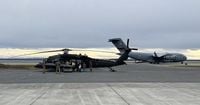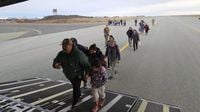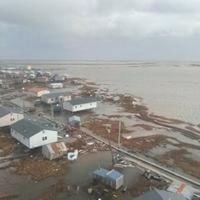Western Alaska is reeling in the aftermath of one of the most catastrophic storms in recent memory, as the full scale of devastation across the Yukon-Kuskokwim Delta becomes clear. In the days following the remnants of Typhoon Halong’s landfall the weekend of October 11-12, 2025, officials, relief workers, and residents have embarked on a massive recovery effort that is testing the limits of resilience in some of the state’s most remote communities.
According to the Alaska Beacon, the storm—packing the force of a Category 2 hurricane—battered coastal villages with tidal surge flooding and hurricane-force winds, displacing more than 2,000 people. The hardest-hit areas, including Kipnuk and Kwigillingok, have seen destruction on a scale rarely witnessed in the region. In Kipnuk, an initial assessment revealed that 121 homes—about 90% of the village—were destroyed, Governor Mike Dunleavy stated in his request to the White House for a major disaster declaration. In Kwigillingok, three dozen homes floated away and more than one-third of residences are now uninhabitable, reported the Anchorage Daily News.
The human toll has been sobering. One woman, 67-year-old Ella Mae Kashatok of Kwigillingok, was killed in the flooding, and two of her family members—Vernon Pavil and Chester Kashatok—remain missing. Search and rescue efforts, led by volunteers and village public safety officers with the Association of Village Council Presidents, are ongoing, as reported by Alaska Beacon. Dozens were plucked from their homes as they floated away, and at least 15 communities across the region have reported substantial damage.
Evacuation has taken place on a scale unprecedented for these isolated communities. C-17 military transport planes and Alaska National Guard helicopters worked around the clock, airlifting hundreds to safety. On October 16 and 17, 2025, flights continued from Kipnuk and Kwigillingok, with evacuees arriving in Bethel and then onward to Anchorage. As of October 18, 2025, more than 2,000 people had taken shelter—some in schools or with relatives in nearby villages, others in emergency shelters set up at the Alaska Airlines Center, the Egan Center, and city recreation centers in Anchorage. Mayor Suzanne LaFrance estimated that up to 2,000 evacuees could arrive in Anchorage by October 19, with about 575 already airlifted by the Alaska National Guard.
For many, the journey was harrowing and abrupt. Dolly Martin, 19, who fled with her mother and siblings, told Alaska Beacon, “My emotions are all over the place.” Many evacuees carried little more than a suitcase and a bag of personal belongings. Some, like Alexie Stone from Kipnuk, are already contemplating a permanent move. “It’s going to be, try to look for a place and find a job,” Stone told the Anchorage Daily News. “We’re starting a new life here in Anchorage.”
For those who remained behind, the work is only beginning. As the stream of evacuees slowed on October 18, officials in Bethel and across Western Alaska prepared to pivot from rescue to recovery. Col. John James of the Alaska Defense Force explained that while some communities like Kipnuk would require extensive repair, others might be stabilized quickly enough to allow residents to return before winter. “There are things we can do immediately,” James said. “If we can go into those communities and assist with anything to prepare them for winter, we’re gonna go through that.”
The urgency is palpable. Winter freeze-up is looming, and the threat of mold in flood-damaged homes is a serious concern. In a pole shed in Bethel, about 20 youth volunteers and Yukon-Kuskokwim Health Corp. (YKHC) staff prepared 300 flood cleanup kits, set to be distributed in the coming week. These kits—containing trash bags, tarps, masks, gloves, disinfectants, soap, mops, brushes, and fans—are “kind of basic stuff to get people started,” YKHC Environmental Health Services Manager Alyssa Leary told the Anchorage Daily News. “The most important thing, really, for these homes that got water in them is to get them dry, get them disinfected to try and prevent mold growth over this coming winter.”
Assessment crews have already evaluated 250 homes in affected communities, and additional disaster recovery personnel are expected to arrive soon to assist with repairs. The focus, said YKHC CEO Dan Winkelman, is on stabilizing homes and infrastructure to “keep people in clean and healthy homes.” That includes “mucking out” flood-damaged homes and restoring utility services to villages like Kwigillingok and Kipnuk, the two most severely damaged communities.
Governor Dunleavy, who toured the stricken villages by helicopter on October 17, acknowledged the scale of the challenge. “We’re going to move quickly,” he said, “to get these folks back up on their feet and running.” Yet, he also recognized the harsh reality: “Due to the time, space, distance, geography, and weather in the affected areas, it is likely that many survivors will be unable to return to their communities this winter.” He added, “Agencies are prioritizing rapid repairs ... but it is likely that some damaged communities will not be viable to support winter occupancy, in America’s harshest climate in the U.S. Arctic.”
To bolster the recovery, Dunleavy submitted a formal request to President Donald Trump for a major disaster declaration, seeking federal assistance for individuals and public infrastructure. Alaska’s congressional delegation sent a letter urging swift approval, as reported by the Anchorage Daily News. The federal government has already been providing support for search and rescue, damage assessments, environmental response, and evacuation.
As the dust settles, stories of resilience and gratitude have emerged. State Representative Nellie Unangiq Jimmie described riding out 100 mph winds with her family in Toksook Bay, unsure if their house would withstand the storm. “We had no choice but to sit in our home and wait to see if our house is going to come off the foundation or if debris is going to bust open our windows,” she recounted. She thanked Anchorage for welcoming evacuees: “You are showing my people, my relatives, my constituents, even if they are far from home, this is still Alaska land and they’re amongst families.”
Even as some, like Lucy Martin of Kwigillingok, hope to return home “hopefully before winter,” the reality for many is that their villages may not be habitable for at least 18 months. For now, the focus remains on stabilizing lives, restoring dignity, and forging a path forward—one step at a time—amid the unforgiving Alaskan landscape.


